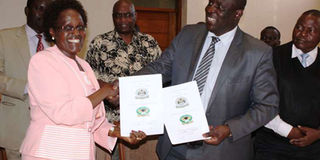Teacher shortfall threat to quality learning

Teacher Service Commission chairperson Lydia Nzomo (right) and Kuppet chairman Omboko Milemba exchange copies of the CBA at a Naivasha hotel, on October 26, 2016. PHOTO | MACHARIA MWANGI | NATION MEDIA GROUP
What you need to know:
- The World Bank and its affiliates are against the Teachers Service Commission hiring more teachers to bridge the shortfall in government schools.
- Instead of the National Treasury allocating enough funds to the TSC to hire enough teachers, the government is investing in technology.
- The government now hires only 5,000 teachers annually, but spends billions of shillings on mega projects with doubtful value.
- Teachers must be properly remunerated to motivate them to execute the reforms.
International financial agencies such as the World Bank and foreign technology firms have continued pushing Kenya to implement education reforms and projects the country is not ready for.
Some of the programmes have led the Ministry of Education, Science and Technology not to seriously consider employing more teachers for public schools.
The World Bank and its affiliates, including technology firms, are against the Teachers Service Commission (TSC) hiring more teachers to bridge the shortfall in government schools.
This position is meant to favour business interests in the developed world keen to see Kenya consume more technology products (electronic gadgets) than help our children acquire knowledge and useful skills.
ALLOCATING ENOUGH FUNDS
Instead of the National Treasury allocating enough funds to the TSC to hire enough teachers, the government is investing in technology, leaving desperate boards of management to settle on contract teachers as a stopgap measure, but which is harmful to the education sector.
The teacher shortfall is now over 100,000. This problem has its roots in the Structural Adjustment Programmes forced on Kenya in the 1980s by the World Bank and its lending arm, the International Monetary Fund.
The SAPs, which were “designed” to stir up change in the education sector, became the single greatest threat to social sector development.
This has had devastating effects on education.
MEGA PROJECTS
The government now hires only 5,000 teachers annually, but spends billions of shillings on mega projects with doubtful value other than being channels for siphoning public money.
Education Cabinet Secretary Fred Matiang’i should advise the government on the effects of these decisions.
Solutions to education challenges must be home-grown. E-learning and e-teaching must take place where everybody has the capacity and access to technology.
As it is now, the laptop project and the entire e-learning/e-teaching is a mere political programme.
There are not enough teachers and the few available are not technologically endowed, and well-remunerated to undertake the envisaged reforms.
SCHOOL INFRASTRUCTURE
We are not against reforms; but they should be implemented alongside other programmes agreed with teachers.
These include reducing the teacher/learner ratios; training teachers on ICT, providing modern teaching/learning tools and upgrading school infrastructure.
More importantly, teachers must be properly remunerated to motivate them to execute the reforms.
Teacher training colleges and universities churn out thousands of teachers annually but who cannot be employed because of lack of funds. Paradoxically, the TSC continues to complain about staff shortfalls.
Why can’t it push for more allocations to employ enough teachers to plug the deficit?
HIRING MORE TEACHERS
The poor skills among pupils graduating from primary school is proof that a new approach is needed to take learners through course-work, and this can only be realised by hiring more teachers.
Kenya has a very high unemployment rate, especially among people aged 15 to 34 years, who constitute more than 40 per cent of the population.
According to the World Bank, about 800,000 youth, mostly from institutions of higher learning, enter the job market annually, majority teachers, but hardly get jobs. In fact, only about 70,000 secure formal sector jobs. Only 5,000 teachers are hired annually.
Kenya needs to create four million jobs for youth by 2020, according to independent surveys. Graduate teachers without meaningful jobs are not only a ticking time bomb, but also a monster that if not effectively tamed, might soon become uncontainable. And this should really worry us.
Mr Sossion is the secretary-general of the Kenya National Union of Teachers





